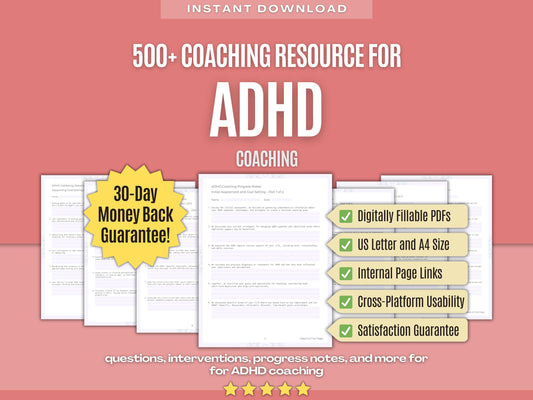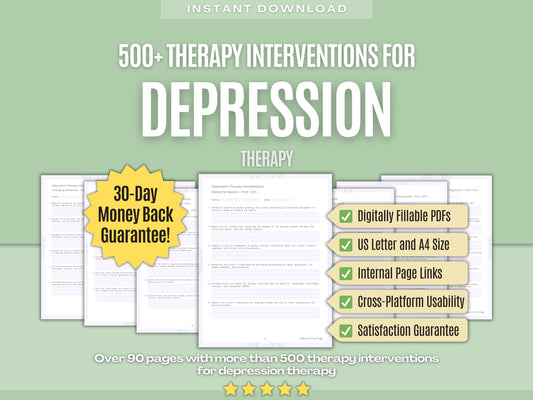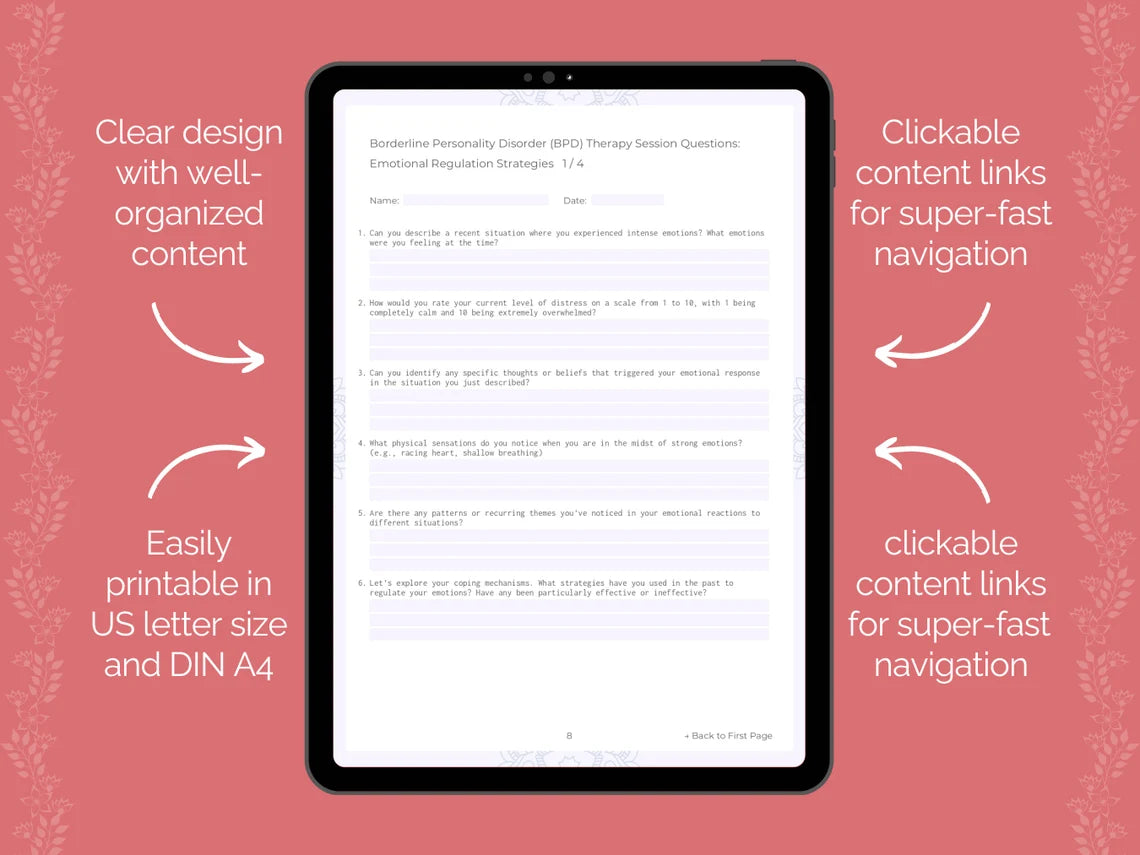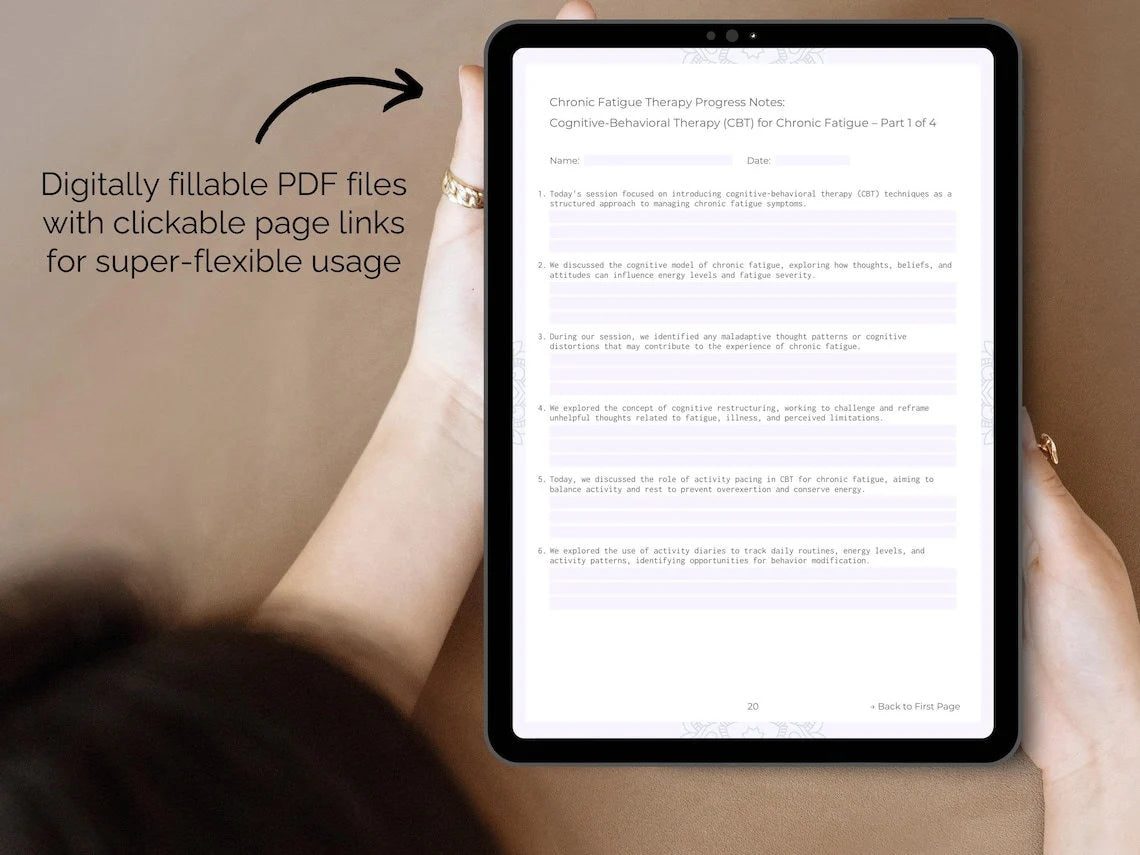Elevate Your Therapy and Guide Your Clients to Inner Healing with Our Dissociative Identity Disorder (DID) Therapy Interventions! ✨
1. Beginning the DID Therapy Process
- Establish a safe and supportive therapeutic environment where the client feels comfortable discussing their experiences and emotions.
- Conduct a thorough assessment of the client's history, symptoms, and experiences of dissociation and identity fragmentation.
- Educate the client about DID, including its symptoms, prevalence, potential causes, and treatment approaches, to increase understanding and reduce stigma.
- Introduce grounding techniques to help the client stay present and connected during therapy sessions, such as deep breathing or sensory grounding exercises.
- Begin exploring the client's internal system of identities, acknowledging the existence of alters and their unique roles and functions.
- Introduce the concept of internal communication and cooperation among alters, emphasizing the importance of working together towards healing and integration.
- Introduce psychoeducation about trauma and its impact on the brain and nervous system, including the fight-flight-freeze response.
- Introduce the concept of containment, teaching the client techniques for safely containing overwhelming emotions or memories.
- Discuss the importance of building a therapeutic alliance and establishing trust between the client and therapist.
- Collaboratively establish boundaries and expectations for therapy sessions, including confidentiality, scheduling, and communication outside of sessions.
- Introduce the concept of journaling as a tool for self-reflection and processing difficult emotions and experiences between therapy sessions.
2. DID Psychoeducation
- Provide a comprehensive overview of Dissociative Identity Disorder (DID), including its definition, prevalence, and diagnostic criteria according to the DSM-5.
- Describe the main symptoms of DID, such as identity fragmentation, amnesia, depersonalization, derealization, and identity confusion.
- Explore the historical and cultural context of DID, including past misconceptions and controversies surrounding the diagnosis.
- Highlight the importance of early detection and intervention for DID to prevent long-term impairment and improve overall functioning.
- Discuss the impact of DID on various areas of functioning, including relationships, work, and daily activities.
- Explain the neurobiological basis of DID, including how trauma affects brain development and the regulation of emotions and memories.
- Discuss the controversy surrounding the diagnosis of DID, including debates about its validity and reliability.
- Explore the role of the therapeutic alliance in DID treatment, emphasizing the importance of collaboration and trust between the therapist and client.
- Describe the various treatment approaches for DID, including psychotherapy, medication, and adjunctive therapies.
- Explore the potential challenges and obstacles in treating DID, such as resistance, denial, and difficulties in establishing trust and cooperation among alters.
- Discuss the importance of safety planning and crisis management in DID therapy, particularly in cases where the client is at risk of self-harm or suicide.
3. Mindfulness for DID
- Begin by explaining the concept of mindfulness to the client, emphasizing its potential benefits for individuals with Dissociative Identity Disorder (DID).
- Explore the role of mindfulness in grounding and stabilizing the client's experience, helping them to stay present and connected during therapy sessions and in daily life.
- Teach the client how to anchor their attention in the present moment by focusing on their breath, the sensations in their body, or their immediate surroundings.
- Introduce the concept of "observing ego," encouraging the client to cultivate a nonjudgmental and compassionate stance towards their own internal experiences.
- Introduce the STOP technique as a tool for interrupting automatic reactions and responding more skillfully to challenging situations.
- Explore strategies for integrating mindfulness into daily life, such as setting reminders, incorporating mindfulness into routine activities, and creating a supportive environment.
- Explore the connection between mindfulness and self-awareness, teaching the client how to observe their thoughts, feelings, and behaviors without becoming fused with them.
- Discuss the potential benefits of mindfulness for improving concentration, focus, and cognitive functioning in individuals with DID.
- Introduce loving-kindness meditation as a practice for cultivating compassion towards oneself and others, acknowledging the inner struggles and challenges of living with DID.
- Explore the connection between mindfulness and relational mindfulness, teaching the client how to bring mindful awareness to their interactions with others.
- Discuss the importance of practicing self-care and setting boundaries in mindfulness practice, encouraging the client to prioritize their own well-being.
4. Dialectical Behavior Therapy (DBT) for Emotional Regulation
- Begin by introducing the concept of Dialectical Behavior Therapy (DBT) and its relevance to treating emotional dysregulation in Dissociative Identity Disorder (DID), emphasizing its focus on mindfulness, distress tolerance, emotion regulation, and interpersonal effectiveness skills.
- Conduct a thorough assessment of the client's emotional dysregulation, including their triggers, patterns of reactivity, and coping strategies, to identify areas for intervention.
- Introduce mindfulness skills training to help the client increase their awareness of their emotions, thoughts, and bodily sensations, and learn to observe them without judgment or attachment.
- Introduce distress tolerance skills to help the client cope with intense emotions without resorting to maladaptive behaviors, such as self-harm or substance use.
- Explore the client's patterns of emotional avoidance and impulsivity, and work towards developing more adaptive coping strategies for managing emotional triggers.
- Teach the client emotion regulation strategies, such as cognitive reappraisal, problem-solving, and behavioral activation, to help them respond more effectively to emotional triggers.
- Introduce cognitive restructuring techniques to help the client challenge and modify their maladaptive beliefs and interpretations about emotions.
- Explore the client's interpersonal patterns and relationship dynamics, and how these may contribute to their emotional dysregulation, using interpersonal effectiveness skills training.
- Discuss the importance of building a life worth living, and explore with the client their values, goals, and aspirations, using values clarification exercises.
- Address any barriers or obstacles to using DBT skills that the client may face, such as difficulties with motivation, consistency, or generalization of skills to real-life situations.
- Discuss the importance of practicing mindfulness and using skills regularly, and work towards incorporating DBT skills into the client's daily routine and lifestyle.
5. Interpersonal Connections (IPT) for DID
- Start with psychoeducation about interpersonal relationships and how they can impact DID symptoms.
- Explore the individual's past and present relationships to identify patterns and triggers for dissociation.
- Practice emotion regulation skills to manage intense emotions that may arise during discussions of relationships.
- Explore attachment styles and how they influence interpersonal dynamics in relationships.
- Explore the impact of trauma on the individual's ability to trust others and form meaningful connections.
- Practice communication skills, including active listening and effective expression of needs and boundaries.
- Explore the concept of self-disclosure and its role in building intimacy in relationships.
- Explore the concept of parallel processes in therapy and interpersonal relationships.
- Practice mindfulness techniques to increase awareness of interpersonal dynamics in the present moment.
- Role-play scenarios involving conflict resolution to practice assertive communication skills.
- Practice self-soothing techniques to manage distress in challenging interpersonal situations.
6. Emotion-Focused Therapy (EFT) for Emotional Processing
- Begin by creating a safe and supportive therapeutic environment where individuals feel comfortable exploring their emotions.
- Encourage individuals to identify and label their emotions, helping them develop greater emotional awareness and vocabulary.
- Explore the function and purpose of emotions within the context of the individual's life experiences and relationships.
- Use emotion-focused techniques such as emotion tracking to help individuals identify patterns and triggers for specific emotional states.
- Use emotion-focused imagery exercises to help individuals access and process emotionally charged memories or experiences.
- Use emotion-focused role-playing exercises to help individuals explore and experiment with different ways of expressing and regulating their emotions.
- Explore the connection between unprocessed emotions and dissociative symptoms, helping individuals understand how emotional processing can facilitate symptom reduction.
- Use guided imagery or visualization exercises to help individuals create a safe internal space where they can explore and process their emotions.
- Encourage individuals to explore and express emotions that may have been suppressed or denied as a result of trauma or societal expectations.
- Facilitate emotional processing through guided narrative or storytelling exercises, allowing individuals to explore and make sense of their emotional experiences.
- Encourage individuals to practice self-compassion and self-validation when experiencing difficult emotions, helping them develop greater emotional resilience.
7. Psychodynamic Exploration for DID
- Establish a safe and trusting therapeutic relationship where individuals feel comfortable exploring their inner experiences and identities.
- Encourage individuals to explore their childhood experiences and early attachments to identify potential roots of dissociation and identity fragmentation.
- Explore the individual's internal conflicts and tensions between different identities within the DID system, using techniques such as internal dialogue or ego-state therapy.
- Explore the role of trauma in shaping the individual's psyche and contributing to the development of dissociative symptoms and identity fragmentation.
- Encourage individuals to explore their dreams and fantasies as a window into unconscious conflicts, desires, and fears.
- Use exploration of childhood attachment patterns and relational dynamics to help individuals understand their current patterns of behavior and interpersonal relationships.
- Utilize psychodynamic interpretations to help individuals connect past experiences with present symptoms and interpersonal patterns.
- Foster exploration of the individual's relationship with their primary caregiver(s) and the ways in which these early attachments may influence current patterns of relating and identity formation.
- Encourage exploration of the individual's sense of identity and self-concept, including how different identities within the DID system may represent different aspects of the self.
- Foster exploration of unconscious desires, fears, and conflicts that may be driving the individual's symptoms and behaviors.
- Use exploration of transference and countertransference dynamics to deepen the therapeutic relationship and uncover unconscious relational patterns.
8. Healing Sounds: Music Therapy for DID
- Begin by establishing a safe and supportive therapeutic environment where individuals with DID feel comfortable exploring their experiences through music.
- Provide a variety of musical instruments and resources such as drums, keyboards, guitars, and percussion instruments to cater to individual preferences and interests.
- Encourage individuals to create their own music or songs as a means of self-expression and emotional release.
- Encourage individuals to create playlists of music that resonates with their experiences, emotions, and inner selves, using these playlists as a tool for self-reflection and exploration.
- Use songwriting as a tool for narrative reconstruction and identity integration, allowing individuals to tell their stories and explore different aspects of their identity through lyrics and melody.
- Use music as a tool for building trust and rapport within the therapeutic relationship, providing individuals with a nonverbal means of communication and expression.
- Utilize live music performance or improvisation sessions as a means of building confidence and self-esteem, providing individuals with opportunities to showcase their musical talents and creativity.
- Use music as a means of processing and integrating traumatic memories, providing individuals with a safe and supportive container for exploring difficult emotions and experiences.
- Provide psychoeducation on the therapeutic benefits of music, including its ability to access and engage different parts of the brain and nervous system.
- Encourage individuals to explore their relationship with music and its significance in their lives, helping them uncover meaningful connections between music and their experiences with DID.
- Provide opportunities for individuals to engage in guided relaxation and mindfulness exercises accompanied by music, helping them cultivate a sense of presence and awareness in the present moment.
9. Wrapping Up the DID Therapy Session
- Reflect on the progress made during the session, highlighting any insights, breakthroughs, or challenges that emerged.
- Summarize the key themes or topics discussed during the session, ensuring clarity and understanding on both sides.
- Provide psychoeducation or skill-building exercises related to managing dissociative symptoms or coping with distress between sessions.
- Encourage the individual to engage in self-care activities between sessions, emphasizing the importance of nurturing their well-being.
- Offer reassurance and support for any difficult emotions or experiences that arose during the session, emphasizing that they are not alone in their journey.
- Normalize the ups and downs of the therapeutic process, reassuring the individual that progress often occurs in nonlinear ways.
- Offer encouragement and validation for the individual's efforts and accomplishments, no matter how small they may seem.
- Address any logistical or administrative matters related to scheduling, billing, or paperwork, ensuring clarity and transparency in the therapeutic process.
- Validate the importance of self-reflection and introspection in the healing process, emphasizing that insights often arise outside of therapy sessions.
- Reinforce the confidentiality of the therapeutic relationship and the importance of maintaining boundaries between sessions.
- Offer words of encouragement and support as the session comes to a close, reinforcing the therapeutic alliance and the individual's sense of agency and empowerment.
10. Closing the DID Therapy Journey
- Reflect on the individual's progress and growth throughout their therapy journey, acknowledging the challenges they have overcome and the strengths they have developed.
- Review the goals that were set at the beginning of therapy and celebrate the achievements and milestones that have been reached.
- Discuss any remaining goals or areas of focus that the individual may want to address in the future, providing guidance and support for continued growth and development.
- Offer words of encouragement and validation for the individual's efforts and accomplishments, emphasizing their capacity for resilience and transformation.
- Explore any fears or concerns the individual may have about ending therapy and provide reassurance and support as they transition to the next phase of their journey.
- Offer resources or referrals for continued support outside of therapy, such as support groups, online communities, or self-help resources.
- Provide psychoeducation on the potential for setbacks or relapses after therapy has ended and discuss strategies for managing these challenges effectively.
- Explore the individual's strengths and resources, helping them recognize their own inner resilience and capacity for growth.
- Validate any feelings of loss or grief the individual may experience about ending therapy, emphasizing that it is a normal part of the process of closure and transition.
- Offer a space for the individual to reflect on their therapy journey and share any insights or reflections they have gained along the way.
- Express gratitude for the individual's trust and willingness to engage in therapy, acknowledging the privilege of being a part of their healing journey.
We hope that our therapy interventions for Dissociative Identity Disorder (DID) therapy will help you to elevate your therapy practice and guide your clients to inner healing! Do you need more therapy interventions for Dissociative Identity Disorder (DID) therapy? Find them all in our Digital Workbook! Or do you have any questions or suggestions for us? Please feel free to contact us at any time!


















